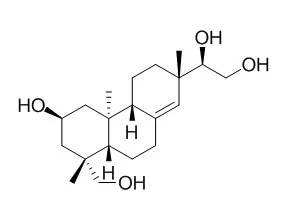| Kinase Assay: |
| Biochem Biophys Res Commun. 2014 Mar 7;445(2):433-8. | | Kirenol inhibits adipogenesis through activation of the Wnt/β-catenin signaling pathway in 3T3-L1 adipocytes.[Pubmed: 24530909] | Kirenol, a natural diterpenoid compound, has been reported to possess anti-oxidant, anti-inflammatory, anti-allergic, and anti-arthritic activities; however, its anti-adipogenic effect remains to be studied. The present study evaluated the effect of Kirenol on anti-adipogenesis through the activation of the Wnt/β-catenin signaling pathway.
METHODS AND RESULTS:
Kirenol prevented intracellular lipid accumulation by down-regulating key adipogenesis transcription factors [peroxisome proliferator-activated receptor γ (PPARγ), CCAAT/enhancer binding proteins α (C/EBPα), and sterol regulatory element binding protein-1c (SREBP-1c)] and lipid biosynthesis-related enzymes [fatty acid synthase (FAS) and acetyl-CoA carboxylase (ACC)], as well as adipocytokines (adiponectin and leptin). Kirenol effectively activated the Wnt/β-catenin signaling pathway, in which Kirenol up-regulated the expression of low density lipoprotein receptor related protein 6 (LRP6), disheveled 2 (DVL2), β-catenin, and cyclin D1 (CCND1), while it inactivated glycogen synthase kinase 3β (GSK3β) by increasing its phosphorylation. Kirenol down-regulated the expression levels of PPARγ and C/EBPα, which were up-regulated by siRNA knockdown of β-catenin.
CONCLUSIONS:
Overall, Kirenol is capable of inhibiting the differentiation and lipogenesis of 3T3-L1 adipocytes through the activation of the Wnt/β-catenin signaling pathway, suggesting its potential as natural anti-obesity agent. | | Fitoterapia. 2014 Oct;98:59-65. | | Kirenol stimulates osteoblast differentiation through activation of the BMP and Wnt/β-catenin signaling pathways in MC3T3-E1 cells.[Pubmed: 25062891] | Kirenol has been reported to possess anti-oxidant, anti-inflammatory, anti-allergic, anti-adipogenic, and anti-arthritic activities; however, its effect on osteoblast differentiation has not yet been reported. The aim of the present study was to evaluate the effect of Kirenol on osteoblast differentiation through activation of the bone morphogenetic protein (BMP) and Wnt/β-catenin signaling pathways in MC3T3-E1 cells.
METHODS AND RESULTS:
Kirenol markedly promoted alkaline phosphatase (ALP) activity and mineralization. Kirenol not only increased the expression of osteoblast differentiation markers, such as ALP, type I collagen (ColA1), and osteopontin (OPN), but also increased the expression of osteoprotegerin/receptor activator of nuclear factor kappa B ligand (OPG/RANKL) ratio. The effects of Kirenol on osteoblast differentiation were accompanied by stimulating the expression of the BMP and Wnt/β-catenin signaling pathways, including BMP2, runt-related transcription factor 2 (Runx2), osterix (Osx), low density lipoprotein receptor related protein 5 (LRP5), disheveled 2 (DVL2), β-catenin, cyclin D1 (CCND1), and phosphorylated glycogen synthase kinase 3β (GSK3β). In addition, Kirenol up-regulated the expression of β-catenin, CCND1, ALP, and ColA1 which were down-regulated by siRNA knockdown of β-catenin.
CONCLUSIONS:
Overall, these results demonstrate that Kirenol is capable of promoting osteoblast differentiation in MC3T3-E1 cells through activation of the BMP and Wnt/β-catenin signaling pathways, suggesting that it is a potential candidate target for treating or preventing osteoporosis. |
|
| Cell Research: |
| Pharmazie. 2014 Feb;69(2):148-53. | | Kirenol, a compound from Herba Siegesbeckiae, induces apoptosis in human chronic myeloid leukemia K562 cells.[Pubmed: 24640606] | Kirenol is a biologically active substance isolated from Herba Siegesbeckiae.
METHODS AND RESULTS:
In the experiments, we explored a novel antitumor activity of Kirenol. The data demonstrated that Kirenol had strong cytotoxic effects to human chronic myeloid leukemia K562 cells, the 50% inhibitory concentration (IC50) for Kirenol was 53.05 ig/ml, 18.19 pg/ml and 15.08 microg/ml for 24, 48 and 72 h, determined using the MTT assay. Further studies showed that Kirenol treatment caused externalization of phosphatidylserine, accumulation of ROS (reactive oxygen species), alteration of mitochondrial membrane potential, release of cytochrome c, reduction in the level of the Bcl-2 protein and upregulation of Bax and tBid, Kirenol induced cell apoptosis in a caspase-independent manner. Further studies indicated that Kirenol treatment triggered the arrest of cell cycle S period which might resulted from the up-regulation of phosphorylation of p53 (Ser 6 and Ser 37) and expression of p21 protein.
CONCLUSIONS:
Our results indicated that Kirenol possesses antitumor action on human chronic myeloid leukemia K562 cells in vitro. Kirenol may have therapeutic potential for the treatment of cancer that deserves further investigation. |
|
| Animal Research: |
| J Ethnopharmacol. 2011 Sep 1;137(1):774-82. | | Kirenol upregulates nuclear annexin-1 which interacts with NF-κB to attenuate synovial inflammation of collagen-induced arthritis in rats.[Pubmed: 21745559 ] | Kirenol is a diterpenoid compound purified from the Chinese Herba Siegesbeckiae. Siegesbeckiae has been employed for the treatment of arthritis for centuries, its safety and efficacy are documented through a long history of human use.
To investigate the effects on collagen-induced arthritis (CIA) and anti-inflammatory mechanism of Kirenol.
METHODS AND RESULTS:
Kirenol was administrated intragastrically in rats after the onset of CIA. Pathological changes were evaluated by paw swelling and histopathology. Concentration of IL-1β in synovial fluid and adrenal corticotropin (ACTH) in plasma were determined by Elisa. Western blot was performed to detect the expression of annexin-1 and glucocorticoid receptor alpha (GRα) in synovium. NF-κB DNA binding activity was assessed by electrophoretic mobility shift assays (EMSA).
Kirenol (1, 2, and 4 mg/kg) and prednisolone depressed paw swelling and reduced IL-1β of synovial fluid in the CIA rats (p<0.05 or p<0.01). Kirenol and prednisolone upregulated nuclear annexin-1 and inhibited NF-κB activity in synovium of CIA. The inhibitory effect of Kirenol and prednisolone on NF-κB activity was enhanced by anti-annexin-1 Ab. Prednisolone, but not Kirenol, downregulated plasma ACTH and GRα expression significantly (p<0.01).
CONCLUSIONS:
Kirenol and prednisolone can upregulate nuclear annexin-1 which interacts with NF-κB to inhibit NF-κB activity, reduce cytokines expression and thereby attenuate inflammation of CIA joints. Kirenol does not lead to ACTH or GR downregulation, which is in contrast to classic glucocorticoid prednisolone. Kirenol shares with GCs similar anti-inflammatory mechanism but bypass the considerable limitation of GCs treatment. |
|






 Cell. 2018 Jan 11;172(1-2):249-261.e12. doi: 10.1016/j.cell.2017.12.019.IF=36.216(2019)
Cell. 2018 Jan 11;172(1-2):249-261.e12. doi: 10.1016/j.cell.2017.12.019.IF=36.216(2019) Cell Metab. 2020 Mar 3;31(3):534-548.e5. doi: 10.1016/j.cmet.2020.01.002.IF=22.415(2019)
Cell Metab. 2020 Mar 3;31(3):534-548.e5. doi: 10.1016/j.cmet.2020.01.002.IF=22.415(2019) Mol Cell. 2017 Nov 16;68(4):673-685.e6. doi: 10.1016/j.molcel.2017.10.022.IF=14.548(2019)
Mol Cell. 2017 Nov 16;68(4):673-685.e6. doi: 10.1016/j.molcel.2017.10.022.IF=14.548(2019)